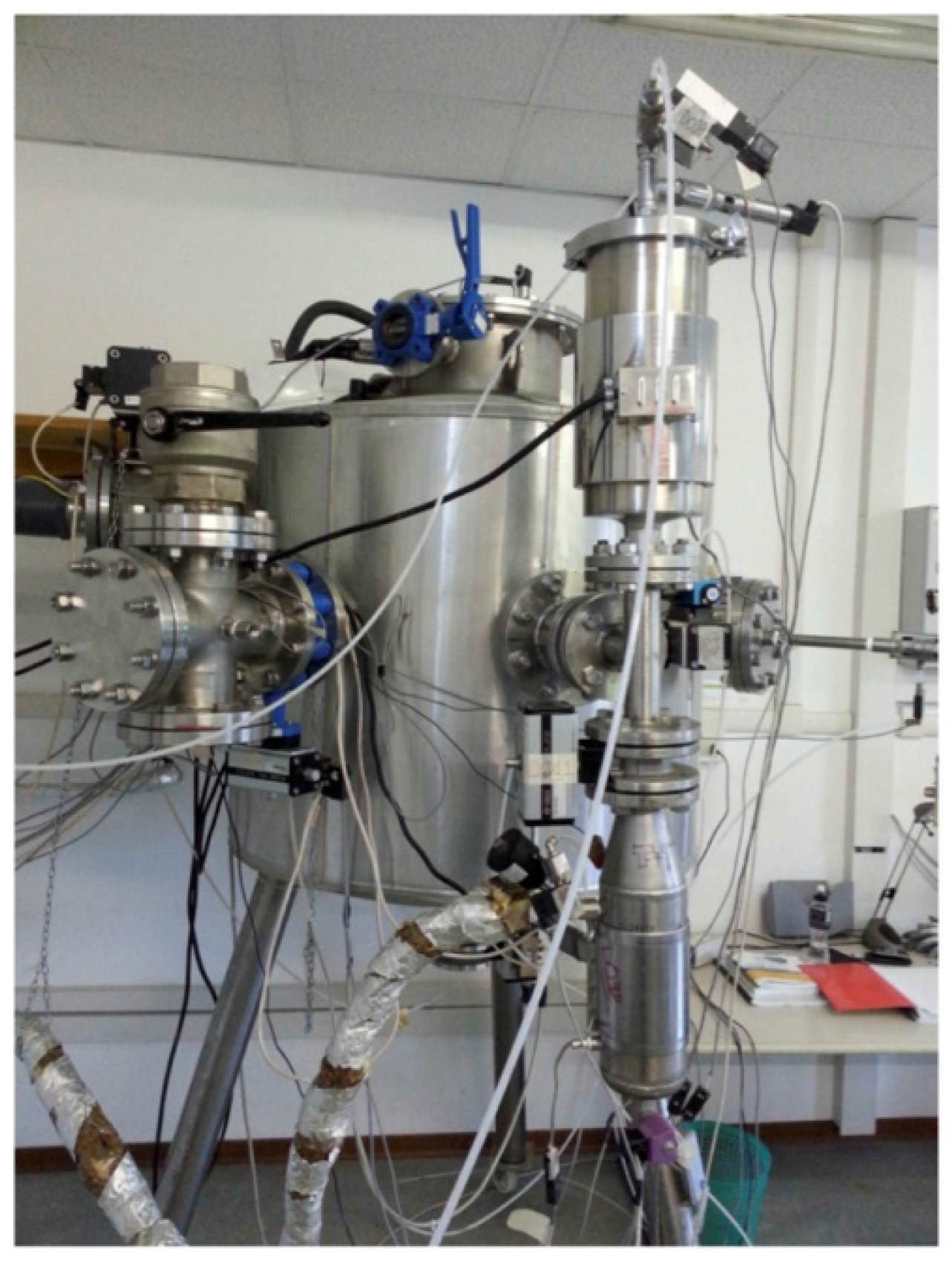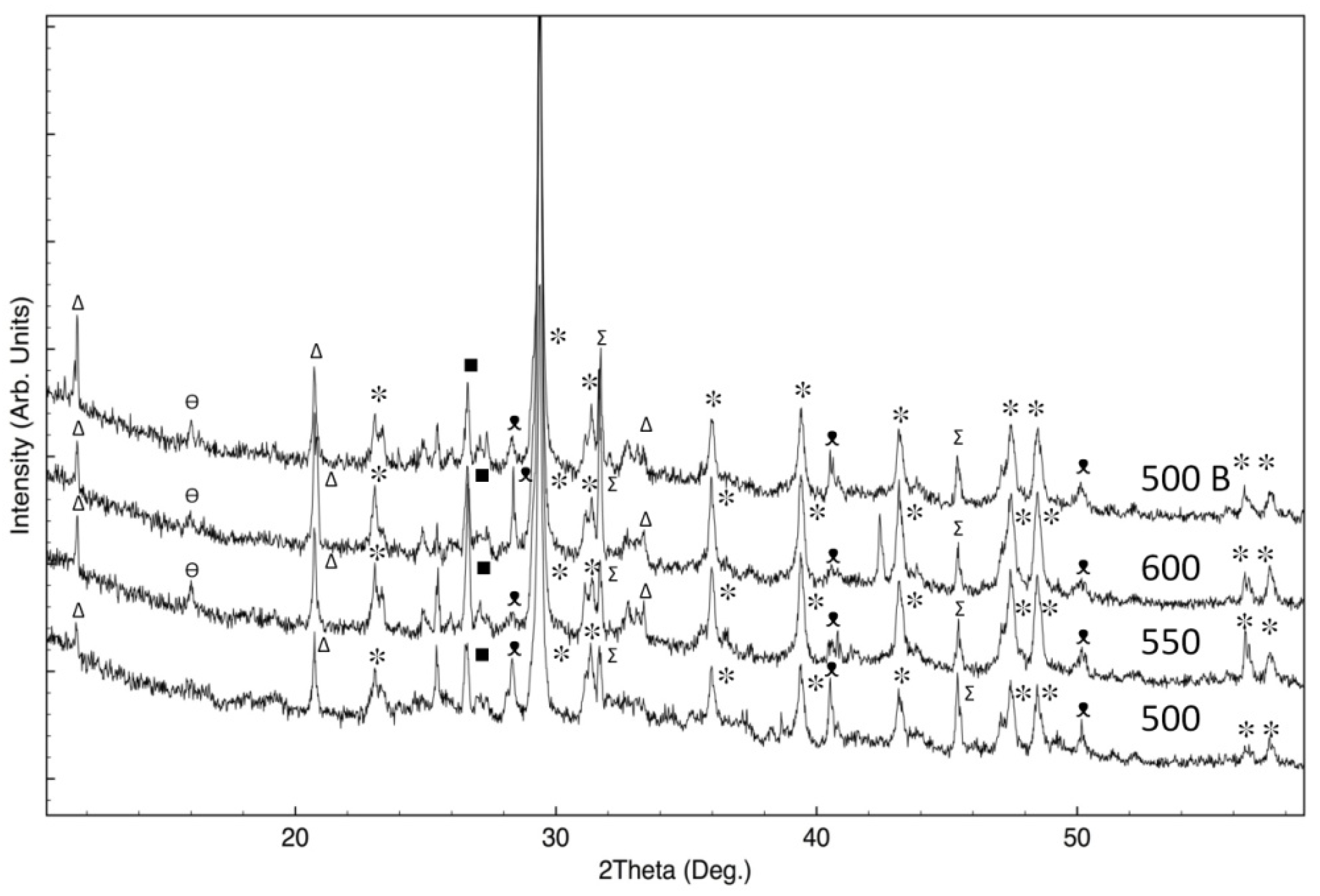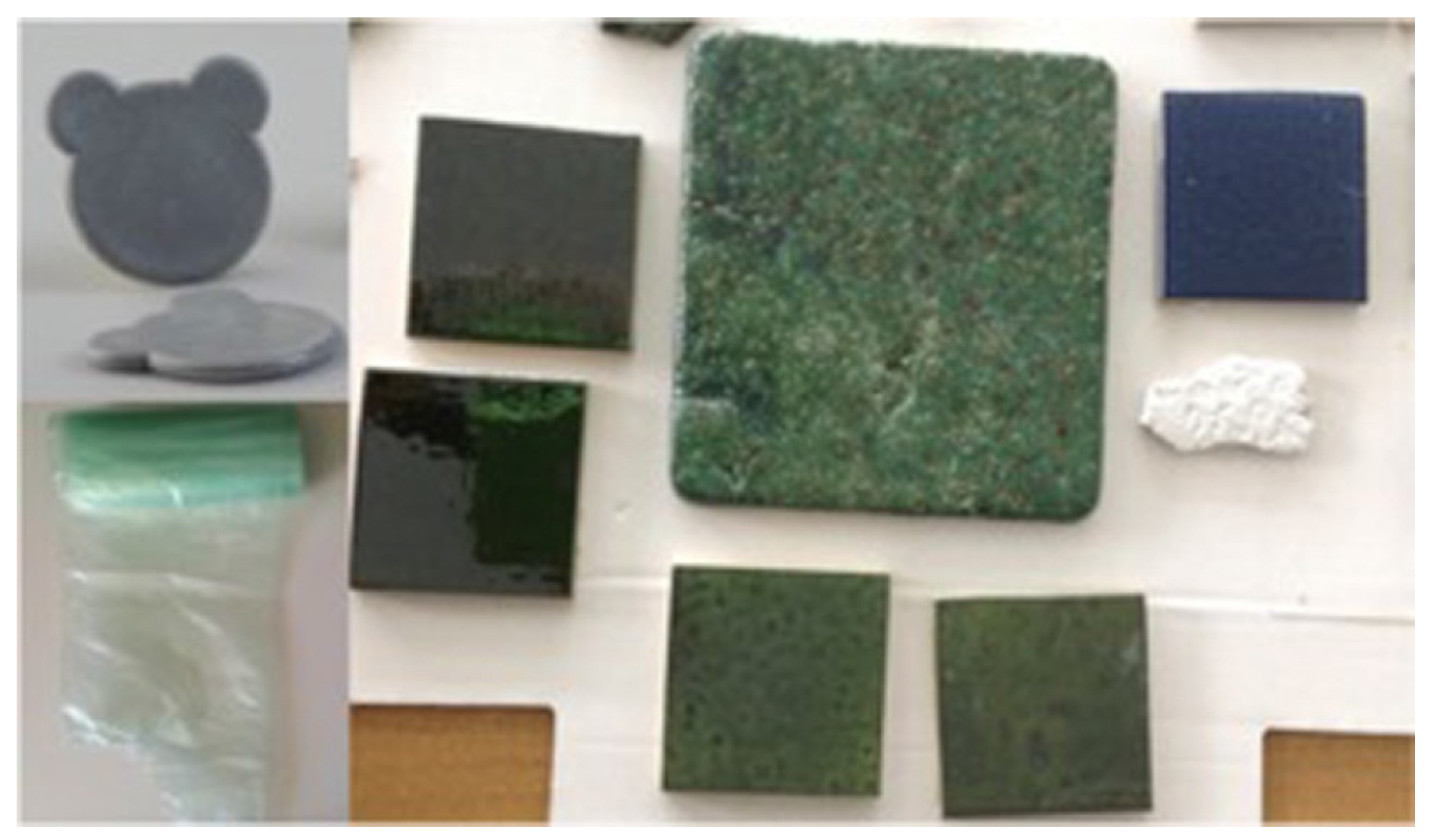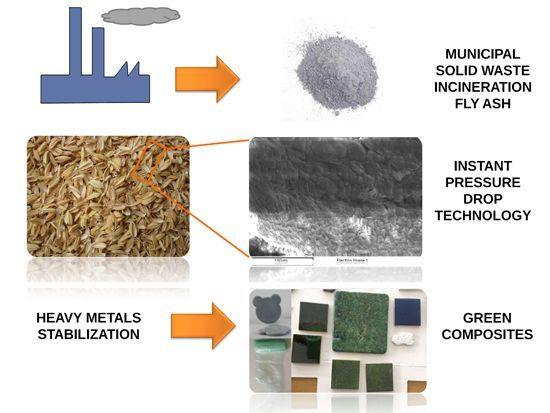1. Introduction
Because of poor combustion efficiency and the lack of air pollution control systems, from its early beginning in the 1870s, waste incineration was considered a very large source of pollution [
1]. From 1950, the first efforts to limit the pollution of incinerators were imposed by law [
2]. However these first limitations did not consider dust emissions, until 1970, when an aggravation of dust emission standards occurred. As a consequence, in the next years, the development of the air pollution control systems started [
1].
Today, while modern waste incineration represents a consolidate technology for volume and mass reduction of the waste, combined with efficient energy recovery and systems to reduce and treat emissions, some concerns regarding the production of toxic waste still exist. In particular, fly ash generated by the air pollution control systems are hazardous waste materials for which landfilling is still considered the most appropriate management strategy. Indeed, this ash contains leachable toxic metals, as for example Pb and Zn [
3].
Great efforts of researchers are now devoted to developing sustainable stabilization technologies able to reuse this toxic ash, also in view of the European need of new solutions for raw materials substitution that are employed in several applications.
In recent works, we proposed the use of silica extracted from rice husk ash (RHA) for heavy metals stabilization of municipal solid waste incineration (MSWI) fly ash [
4]. The new proposed technology was named COSMOS-RICE.
The idea to use this agricultural byproduct is due to its high availability. World rice production in 2011–2012 exceeded 480 million tons [
5]. Rice husk constitutes about 20 wt % of the paddy production and it is an abundantly available biomass, commonly employed as a fuel. Its combustion product, rice husk ash (RHA), usually contains more than 60% silica (SiO
2), and 10%–40% carbon and other minor mineral components. Due to the lower density of RHA, and consequently its bulky form, its disposal can become a problem. In some areas, a large amount of RHA is treated as a waste and landfilled, leading to air and water pollution. Airborne RHA particles have been linked to respiratory disease in humans [
6]. Because rice husk is abundantly available and it can be converted into RHA after being subjected to an almost zero-cost thermal valorization process, more and more researchers have become interested in how to use this waste as a resource [
7].
The stabilization mechanism involved in the COSMOS-RICE technology was extensively discussed [
8]: it is attributed to two different reactions, due to the amorphous silica and carbonation. Indeed, the stabilization mechanism is mainly due to the capability of amorphous silica to entrap heavy metals, but this does not only occur during laboratory treatment, it also proceeds over time thanks to carbonation. The proposed method was very recently improved by the direct use of RHA without passing through silica extraction [
8]. Since the organic part of rice husk (RH) can easily be removed by thermal decomposition, thermal treatment of RH is an approach to obtain, not only energy, but also silica from rice husk.
Production of biochar from rice husk has also attracted many researchers’ attention. This is a versatile material with good adsorption properties. Biochar has a relatively structured carbon matrix with a high degree of porosity and an extensive surface area. It may act as an adsorbent, which is similar in some aspects to activated carbon and it can play an important role in controlling contaminants in the environment [
9]. Chemical impregnation with KOH or NaOH of RHA, followed by activation at 650–850 °C, generates a material with extremely high surface area [
10]. Even though biochar from rice husk has already been employed for removing heavy metals [
11], it was never considered in the COSMOS-RICE technology.
To also obtain biochar from RHA, pyrolysis of rice husk was realized at 500 °C in O2-limiting conditions.
To evaluate the effect on heavy metals stabilization by a pre-treatment of rice husk, the employment of Instant Pressure Drop (DIC) technology [
12] was proposed for the first time.
The DIC technology is based on a thermo-mechanical process that requires some moisture level in the material to be treated. A rapid pressure drop occurs during the material heating, producing bursts of moisture evaporation inside the bulk of material, with the occurrence of a structural damage. It was reported that DIC pre-treatment is able to make a material porous and expanded within short treatment time [
13]. This process is based on the use of vacuum and temperature. Moreover, material properties are fundamental for obtaining different final characteristics of the product.
Several research papers have been published in recent years exploring the use of DIC technology, in particular for food treatment [
14]. Some applications that have been investigated include material sterilization, removal of certain inhibitors in legumes, structural expansion of fruit and vegetables, drying process acceleration, enhancement of extraction of essential oils, coffee extraction, and preservation of food materials [
15,
16,
17]. DIC technology was also applied on rice preservation [
18]. However, it was never employed as a pre-treatment of rice husk.
This paper reports the first work about the application of DIC as a possible new pre-treatment technology for the waste material. The aim of this project is to obtain a safe filler that can be applied in several application, to produce “green composites”. This pioneering work explores the viability of applying DIC technology to pre-treat other waste types.
3. Results and Discussion
Figure 2 shows X-ray diffraction analysis of TQ rice husk ash treated at different temperatures and oven conditions (see
Table 1). The XRD patterns of samples T1 and T2 (DIC pre-treated samples), thermally treated in the same conditions are very similar to corresponding reported TQ samples, hence, for the purposes of clarity, they were not shown in the Figure. From XRD patterns shown in
Figure 2, it appears that all samples are amorphous, with one peak, due to the presence of a crystalline phase.
Figure 2.
X-ray diffraction analysis of TQ rice husk ashes treated at different temperatures (see
Table 1).
Figure 2.
X-ray diffraction analysis of TQ rice husk ashes treated at different temperatures (see
Table 1).
Despite the fact that all patterns can essentially be attributed to the presence of amorphous materials, it is evident that basic materials structures are different: indeed, the integrated areas of the XRD patterns are almost the same for samples treated in O2-limited conditions, but they are extremely different from those regarding samples not treated in O2-limited conditions. Moreover, for the last samples, the integrated XRD area is almost the same.
Samples TQ 500, 550 and 600 show a large and intense halo, in the range of 18°–28°. In the literature it was reported that, for similar samples, the typical silica oxide characteristic broad peak is centered at 2θ = 22.5°, which can be attributed to the presence of disordered cristobalite [
23]. Moreover, the sample TQ 500 B shows a different XRD spectra, with higher intensities, compared to the other shown in the same Figure (the XRD spectra of T1 600 B and T2 600 B are very similar, then are not reported).
The background intensity of sample TQ 500 B, which is extremely high in respect to other samples, can be caused by the amorphous carbon present in the RHA [
24].
In particular, for sample TQ 500 B there is a large halo between 16° and 30°), which can be attributed to (002) stacking of the graphitic basal plans in chars [
25,
26]. Indeed, this halo results at slight higher diffraction angles, in comparison to peak attributed to the silica.
Regarding sample TQ 500 B, another large halo can be found between 38° and 50°. For carbon prepared at different pyrolysis temperatures and for commercial carbon black, X-ray diffraction patterns show two peaks at about 24° and 44°, which were assigned to the planes of graphite (002) and (100) [
27].
Therefore, XRD patterns collected on RHA allow concluding that samples annealed in not O2-limited conditions are mainly made of amorphous silica. On the contrary, samples obtained in O2-limited conditions show an important content of biochar. These results are in accord with data about silica content, obtained by NaOH solubilization. Indeed, the content of silica resulted extremely lower for samples treated in the O2-limited conditions, in respect to other samples (see the Experimental Section).
RHA powders were employed for the COSMOS-RICE stabilization tests conducted with MSWI fly ash.
Table 2 reports the elements concentration in the solutions obtained by making the leaching test on MSWI fly ash, before the stabilization treatment. It appears evident that solution contains some metals. In particular, the toxic elements that can be found in high concentration are Pb and Zn. As it be seen in
Table 2, the concentrations of Pb and Zn are 60 and 14 mg/L, respectively.
Table 2.
Elements concentration and limits of detection (LD) in leaching solutions of MSWI fly ash.
Table 2.
Elements concentration and limits of detection (LD) in leaching solutions of MSWI fly ash.
| Element | Conc. (mg/L) | LD (mg/L) |
|---|
| Cl | 9287 ± 928 | 0.161 |
| K | 1385 ± 138 | 0.092 |
| Ca | 6870 ± 687 | 0.068 |
| Zn | 14.3 ± 1.4 | 0.004 |
| As | 1.6 ± 0.2 | 0.004 |
| Br | 118 ± 12 | 0.004 |
| Rb | 4.0 ± 0.4 | 0.003 |
| Sr | 6.2 ± 0.6 | 0.003 |
| Ba | 8.7 ± 0.9 | 0.033 |
| Pb | 60 ± 6 | 0.004 |
To verify the stabilization efficacy of the different obtained RHAs, one month after the stabilization procedure (samples were left to dry at room temperature for one month) leaching tests were realized. The data about the concentration of Pb and Zn in the leaching solutions of stabilized samples are shown in
Figure 3.
It is very important to highlight that the COSMOS-RICE conditions of synthesis were settled to obtain incomplete stabilization reactions:
i.e., the amount of added RHA was about 1% of the total weight of ash and thus, was much lower than that employed in previous works (around 20% in weight of the global fly ash mix) [
4,
19,
28]. This allows finding residual soluble metals in the leaching solutions, to have the possibility to compare the results obtained by using RHA treated in different manners and discriminate the efficacy of different employed RHAs. As a consequence, the samples that have been most effectively stabilized exhibit lower Pb and Zn concentrations in their leaching solutions (see
Figure 3). Comparing all the data shown in
Figure 3, it results that, despite the low amount of used RHA, the stabilization of MSWI fly ash was obtained: in the leaching solutions, Zn and Pb were reduced at values generally less than one order of magnitude (for example, in sample T2 550, Pb was about 3 mg/L and Zn 1 mg/L).
Figure 3.
Concentration of Zn (
a) and Pb (
b) in the leaching solutions of the COSMOS-RICE samples obtained by using the whole RHA samples (see
Table 1).
Figure 3.
Concentration of Zn (
a) and Pb (
b) in the leaching solutions of the COSMOS-RICE samples obtained by using the whole RHA samples (see
Table 1).
In particular, there are two effects to investigate: the presence of biochar in the RHA and the DIC pre-treatments. The first consideration that can be deduced by comparing the data reported in
Figure 3 concerns the biochar: RHAs that also contains biochar (see the corresponding stabilized samples, TQ 500 B, T1 500 B, and T2 500 B) are globally less efficient in the heavy metals stabilization because of the higher amount of Pb and Zn found in the leaching solutions. On the basis of these results, it is possible to conclude that the stabilization efficacy of COSMOS-RICE technology is reduced when silica content in RHA is decreased. This is an unexpected result, because there are several examples of use of biochar derived from rice husk as metal absorber reported in the literature [
9]. However, the data shown in
Figure 3 highlight that the stabilization is better obtained by silica in respect to biochar contained in RHA.
The data in
Figure 3 are analyzed in more details below, in order to evaluate the role of the DIC treatment in the stabilization process.
Considering Zn, its concentration is very low (it is generally lower than 1 mg/L), except for samples TQ 500 B, T1 500 B, and T2 500 B, where the RHA do not contain mainly silica but also biochar.
Because of the Zn concentration values are very low, it is not possible to enhance a role of DIC pre-treatment in the stabilization of Zn. However, in the case of samples also containing biochar, it seems that T2 DIC pre-treatment is more efficient in comparison to T1 and not DIC not pre-treated sample (TQ).
Data about Pb concentration in the leaching solutions of stabilized samples are about one order of magnitude higher than Zn. Then, some differences about results of stabilization performed using differently treated RHA are more evident. Considering RHA samples treated in the same thermal conditions, but with different pre-treatment, it appears that leaching solution of samples pre-treated with DIC (T1 and T2) show lower Pb concentration, in respect to TQ (except for samples TQ 500 B, T1 500 B, and T2 500 B). In addition, it clearly appears that T2 pre-treatment results the most efficient in all cases. This is probably also due to the fact that T2 involves three DIC cycle repetitions, and thus it resulted more incisive.
The slight differences among the effectiveness of stabilization procedure for all T1 (and T2) samples can be due to the thermal annealing temperature. Generally, a higher annealing temperature allows obtaining a higher silica content in the RHA, which allows a better heavy metals stabilization [
29], in respect to lower annealing temperatures. Indeed, the degradation of organic part present in rice husk occurs starting from 350 °C until about 480 °C [
30]. On the other hand, an increase of the annealing temperature can promote the amorphous silica crystallization, with a reduction of the amount of reactive silica. As a consequence, it is extremely difficult, at these temperatures, to have an idea of the predominant factor, related to the amount of amorphous silica present in the RHA.
SEM images of pre-treated rice husk samples and thermally annealed in different conditions are reported in
Figure 4.
Figure 4.
(
a) SEM images of internal and external surfaces of untreated rice husk (TQ) and pre-treated by T1 and T2 DIC treatments. (
b) SEM images of internal surfaces of corresponding RHA shown in
Figure 4a.
Figure 4.
(
a) SEM images of internal and external surfaces of untreated rice husk (TQ) and pre-treated by T1 and T2 DIC treatments. (
b) SEM images of internal surfaces of corresponding RHA shown in
Figure 4a.
Figure 4a shows the inner and external surfaces of rice husk samples, not pre-treated and pre-treated DIC. As revealed in the SEM image, the external surface of the whole rice husk samples is covered with small irregularly shaped particles that are well aligned. Such domes are shown to be rich in silica. On the contrary, the internal surface of rice husk looks much smoother, and contains a much lower concentration of silicon [
31]. External surfaces of all samples do not show any apparent morphological difference. Instead,
Figure 4a highlight that internal surface of sample T1, and especially sample T2, seems to be more structured in respect to that of TQ sample, with the appearance of some channels. Since the internal part of rice husk contains less amount of silica, it is possible to conclude that DIC seems to produce some structural changes on the organic part of the sample. Indeed, for organic matter it often produces a structure swelling.
Figure 4b reports the SEM images of corresponding samples of
Figure 4a, but after thermal treatment. It was chosen to show the morphology of RHA samples TQ 550, T2 550 and T1 550, to highlight possible morphological differences between samples pre-treated by DIC and not pre-treated (TQ), on the basis of leaching tests results reported in
Figure 3. External surface images are not reported because no differences can be highlighted in the SEM images. It appears evident that, comparing the TQ 550 samples with the corresponding two other samples pre-treated by DIC technology, some morphological differences occurred. Sample T1 550 shows a more structured morphology, very similar to that one obtained for sample T2, before making any thermal annealing (see
Figure 4a). The appearance of some internal channels occurs that result more evidently in respect to T2 sample. This is probably due to thermal treatment at 550 °C, which produce degradation of organic part of rice husk. Indeed, this occurs starting from 350 °C till about to 480 °C [
30], and that may happen in a different manner in respect to TQ sample, because the DIC pre-treatment is done.
Sample T1 and T2 550 have large internal cavities and a more open structure. In order to highlight this strange morphology for these samples, some images were also taken at high magnification (see
Figure 4b). These images reveal a great impact of DIC on the microstructure of pre-treated samples. It can be noted that samples T1 and T2 550 show an inner morphology, made by irregular particles with slit-shaped surfaces that provide an internal porous structure producing a higher surface area in respect to TQ sample. In particular, the sample that shows best results in terms of heavy metals stabilization (T2 550) shows particles with dimensions lower in respect to T1 550. This may results in a better RHA degradation and then, in a higher reactivity of RHA.
Figure 5 shows the XRD patterns collected on COSMOS-RICE samples, obtained by using TQ RHA. All COSMOS-RICE samples, obtained by employing the RHA reported in
Table 1, show very similar XRD patterns. For this reason, only those of stabilized samples obtained by using TQ RHA are shown.
Figure 5.
XRD patterns collected on COSMOS-RICE samples, obtained by using TQ RHA (see
Table 1). ✻: Calcite (CaCO
3); Σ: Halite (NaCl); Δ: Gypsum [CaSO
4·2(H
2O)]; θ: Thaumasite [Ca
3(SO
4)[Si(OH)
6](CO
3)·12(H
2O)]; ▪: Quartz (SiO
2); ᴥ Potassium chloride (KCl).
Figure 5.
XRD patterns collected on COSMOS-RICE samples, obtained by using TQ RHA (see
Table 1). ✻: Calcite (CaCO
3); Σ: Halite (NaCl); Δ: Gypsum [CaSO
4·2(H
2O)]; θ: Thaumasite [Ca
3(SO
4)[Si(OH)
6](CO
3)·12(H
2O)]; ▪: Quartz (SiO
2); ᴥ Potassium chloride (KCl).
It is possible to see that all the samples contain calcite, gypsum, quartz, sylvite, halite, and thaumasite; like the phase mineralogy already reported for samples obtained by COSMOS-RICE technology. These phases are compatible with the employ of this material as a filler, to produce several composites. The stabilization mechanism involving amorphous silica reactions and carbonation has been already reported and discussed [
8]. In particular, data shown in
Figure 5 allows highlighting that the use of RHA obtained by different DIC pre-treatments does not produce any changes of the crystalline phases in the final stabilized materials. Indeed, DIC may influence the combustion efficiency of rice husk: it was shown that the RHA morphology appears more structured with consequences on the surface area. Therefore, at the same temperature, the combustion of organic part may result more efficient in samples pre-treated by DIC, with an increase of the silica concentration.
Work is in progress to evaluate the capability of DIC pre-treatment to increase the calorific efficiency of rice husk.
Figure 6 show some “green composites” realized by using COSMOS-RICE technology, to obtain a new filler material. The new filler was inserted in polyethylene (30% in weight) and polyethylene foils (5% in weight). In addition, it was also employed to obtain tiles, with different colors (from 30% to 50% in weight). The presence of soluble salts may affect the employment of this material in building application. However, it was already shown that it is possible to wash the filler and recover almost pure soluble salts [
19].
Figure 6.
Pictures of several “green composites” realized by using the material produced with the COSMOS-RICE technology as a filler. It was inserted in polyethylene (30% in weight) and polyethylene foils (5% in weight). In addition, it was also employed to obtain tiles, with different colors (from 30% to 50% in weight).
Figure 6.
Pictures of several “green composites” realized by using the material produced with the COSMOS-RICE technology as a filler. It was inserted in polyethylene (30% in weight) and polyethylene foils (5% in weight). In addition, it was also employed to obtain tiles, with different colors (from 30% to 50% in weight).















